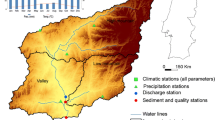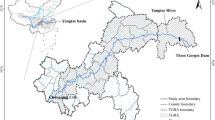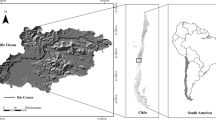Abstract
Lush Hyrcanian mixed temperate forests are globally important ecosystems with considerable ecological and economic values and high variety of ecosystem services (ES). In this study, an ES-based approach is adopted to develop a spatial conservation framework for Gorganrood Watershed, northeastern Iran. In doing so, the integrated valuation of ecosystem services and trade-offs modeling tool was implemented to spatially quantify a collection of five ES including soil retention, habitat quality (as a proxy for biodiversity), water yield, food supply and carbon storage. These services were integrated into a single layer based on the Total Ecosystem Services (TES) index. By performing correlation analyses, the type and the strength of relationships between ES, TES index values and different land features were analyzed to reveal which land-use categories at what locations are more capable to provide bundles of ES. Accordingly, Hyrcanian mixed temperate forests in the southern sub-watersheds of the area were detected to have higher potential for simultaneous provisioning of multiple ES. In addition, we show that biodiversity hotspots and provision of other ES are highly correlated and thus that conservation of one group can be beneficial for the other. Our findings are particularly applicable in areas where complex network of land-uses and limited resources are major barriers against effective conservation of Hyrcanian mixed temperate forests.





Similar content being viewed by others
References
Ai J, Sun X, Feng L, Li Y, Zhu X (2015) Analyzing the spatial patterns and drivers of ecosystem services in rapidly urbanizing Taihu Lake Basin of China. Front Earth Sci 9(3):531–545
Allen RG, Pereira LS, Raes D, Smith M (1998) Crop evapotranspiration. Guidelines for computing crop water requirements. FAO irrigation and drainage paper 56. Food and Agriculture Organization of the United Nations, Rome, Italy
Amirnejad H, Khalilian S, Assareh MH, Ahmadian M (2006) Estimating the existence value of north forests of Iran by using a contingent valuation method. Ecol Econ 58(4):665–675
Bagstad KJ, Semmens DJ, Ancona ZH, Sherrouse BC (2016) Evaluating alternative methods for biophysical and cultural ecosystem services hotspot mapping in natural resource planning. Landscape Ecol. doi:10.1007/s10980-016-0430-6
Bai Y, Zhuang C, Ouyang Z, Zheng H, Bo J (2011) Spatial characteristics between biodiversity and ecosystem services in a human-oriented watershed. Ecol Complex 8(2):177–183
Benayas JMR, Bullock JM (2012) Restoration of biodiversity and ecosystem services on agricultural land. Ecosystems 15(6):883–899
Bennett EM, Peterson GD, Gordon LJ (2009) Understanding relationships among multiple ecosystem services. Ecol Lett 12(12):1394–1404
Carpenter SR, Mooney HA, Agard J, Capistrano D, DeFries RS, Díaz S, Dietz T, Duraiappah AK, Oteng-Yeboah A, Pereira HM, Perrings C, Reid WV, Sarukhan J, Scholes RJ, Whyte A (2009) Science for managing ecosystem services: beyond the millennium ecosystem assessment. Proc Natl Acad Sci USA 106(5):1305–1312
Cimon-Morin J, Darveau M, Poulin M (2013) Fostering synergies between ecosystem services and biodiversity in conservation planning: a review. Biol Conserv 166:144–154
Comprehensive Forest Management Report of Gorganrood Watershed. 2015. Published by Forests, Ranges and Watershed Management Organization of the Golestan Province. Gorgan City, Iran
Deore MSJ (2005) Prioritization of micro-watersheds of upper Bhama Basin on the basis of soil erosion risk using remote sensing and GIS technology. Doctoral dissertation, University of Pune Pune
Diodato N, Bellocchi G (2007) Estimating monthly (R) USLE climate input in a Mediterranean region using limited data. J Hydrol 345(3):224–236
Donohue RJ, Roderick ML, McVicar TR (2012) Roots, storms and soil pores: incorporating key ecohydrological processes into Budyko’s hydrological model. J Hydrol 436–437:35–50
Droogers P, Allen RG (2002) Estimating reference evapotranspiration under inaccurate data conditions. Irrigat Drain Syst 16(1):33–45
Egoh B, Rouget M, Reyers B, Knight AT, Cowling RM, van Jaarsveld AS, Welz A (2007) Integrating ecosystem services into conservation assessments: a review. Ecol Econ 63(4):714–721
Egoh B, Reyers B, Rouget M, Richardson DM, Le Maitre DC, van Jaarsveld AS (2008) Mapping ecosystem services for planning and management. Agric Ecosyst Environ 127(1–2):135–140
Foley JA, DeFries R, Asner GP, Barford C, Bonan G, Carpenter SR, Chapin FS, Coe MT, Daily GC, Gibbs HK, Helkowski JH, Holloway T, Howard EA, Kucharik CJ, Monfreda C, Patz JA, Prentice IC, Ramankutty N, Snyder PK (2005) Global consequences of land use. Science 309:570–574
Golestan Province Land-use Planning Report (2013) Published by Gorgan University of Agriculture and Natural Resources, edited by Abdolrassoul Salmanmahiny. Gorgan City, Iran
Gregori E, Andrenelli MC, Zorn G (2006) Assessment and classification of climatic aggressiveness with regard to slope instability phenomena connected to hydrological and morphological processes. J Hydrol 329(3):489–499
Haines-Young R, Potschin M (2010) Proposal for a common international classification of ecosystem goods and services (CICES) for integrated environmental and economic accounting. European Environment Agency, New York
Holland RA, Eigenbrod F, Armsworth PR, Anderson BJ, Thomas CD, Heinemeyer A, Gillings S, Roy DB, Gaston KJ (2011) Spatial covariation between freshwater and terrestrial ecosystem services. Ecol Appl 21(6):2034–2048
Intergovernmental Panel on Climate Change (IPCC) (2006) IPCC guidelines for national greenhouse gas inventories, volume 4: agriculture, forestry and other land use. In: Eggleston HS, Buendia L, Miwa K, Ngara T, Tanabe K (eds) Prepared by the national greenhouse gas inventories programme. Institute for Global Environmental Strategies (IGES), Hayama. http://www.ipcc-nggip.iges.or.jp/public/2006gl/vol4.html
Kareiva P, Tallis H, Ricketts TH, Daily GC, Polasky S (2011) Natural capital: theory and practice of mapping ecosystem services. Oxford University Press, Oxford
Kouli M, Soupios P, Vallianatos F (2009) Soil erosion prediction using the revised universal soil loss equation (RUSLE) in a GIS framework, Chania, Northwestern Crete, Greece. Environ Geol 57(3):483–497
Landuyt D, Broekx S, Goethals PL (2016) Bayesian belief networks to analyse trade-offs among ecosystem services at the regional scale. Ecol Ind 71:327–335
Larigauderie A, Prieur-Richard A-H, Mace GM, Lonsdale M, Mooney HA, Brussaard L, Cooper D, Cramer W, Daszak P, Díaz S, Duraiappah A, Elmqvist T, Faith DP, Jackson LE, Krug C, Leadley PW, Le Prestre P, Matsuda H, Palmer M, Perrings C, Pulleman M, Reyers B, Rosa EA, Scholes RJ, Spehn E, Turner Ii B, Yahara T (2012) Biodiversity and ecosystem services science for a sustainable planet: the DIVERSITAS vision for 2012–20. Curr Opin Environ Sustain 4(1):101–105
Laterra P, Orúe ME, Booman GC (2012) Spatial complexity and ecosystem services in rural landscapes. Agr Ecosyst Environ 154:56–67
Leh MD, Matlock MD, Cummings EC, Nalley LL (2013) Quantifying and mapping multiple ecosystem services change in West Africa. Agr Ecosyst Environ 165:6–18
Loureiro N, de Azevedo Coutinho M (2001) A new procedure to estimate the RUSLE EI 30 index, based on monthly rainfall data and applied to the Algarve region, Portugal. J Hydrol 250(1):12–18
Mahiny AS, Clarke KC (2012) Guiding SLEUTH land-use/land-cover change modeling using multicriteria evaluation: towards dynamic sustainable land-use planning. Environ Plan 39(5):925–944
Mahiny AS, Clarke KC (2013) Simulating hydrologic impacts of urban growth using SLEUTH, multi Criteria evaluation and runoff modeling. J Environ Inform 22(1):27–38
Margules CR, Pressey RL (2000) Systematic conservation planning. Nature 405(6783):243–253
Millennium Ecosystem Assessment (2005) Ecosystems and human well-being: scenarios: findings of the Scenarios Working Group, vol 2. Island Press, Washington
Nachtergaele FO, van Velthuizen H, Verelst L, Batjes NH, Dijkshoorn JA, van Engelen VWP, Fischer G, Jones A, Montanarella L, Petri M, Prieler S (2008) Harmonized world soil database (version 1.0). Food and Agriculture Organization of the United Nations, Rome
Nemec K, Raudsepp-Hearne C (2013) The use of geographic information systems to map and assess ecosystem services. Biodivers Conserv 22(1):1–15
Pan Y, Xu Z, Wu J (2013) Spatial differences of the supply of multiple ecosystem services and the environmental and land use factors affecting them. Ecosyst Serv 5:4–10
Polasky S, Nelson E, Pennington D, Johnson KA (2011) The impact of land-use change on ecosystem services, biodiversity and returns to landowners: a case study in the State of Minnesota. Environ Resource Econ 48(2):219–242
Pretty JN, Noble AD, Bossio D, Dixon J, Hine RE, Penning de Vries FW, Morison JI (2006) Resource-conserving agriculture increases yields in developing countries. Environ Sci Technol 40(4):1114–1119
Qin K, Li J, Yang X (2015) Trade-off and synergy among ecosystem services in the Guanzhong-Tianshui Economic Region of China. Int J Environ Res Publ Health 12(11):14094–14113
Raudsepp-Hearne C, Peterson GD, Bennett EM (2010) Ecosystem service bundles for analyzing tradeoffs in diverse landscapes. Proc Natl Acad Sci 107(11):5242–5247
Renard KG, Freimund JR (1994) Using monthly precipitation data to estimate the R-factor in the revised USLE. J Hydrol 157(1):287–306
Renard KG, Foster GR, Weesies GA, McCool DK, Yoder DC (1997) Predicting soil erosion by water: a guide to conservation planning with the revised universal soil loss equation (RUSLE), vol 703. US Department of Agriculture, Agricultural Research Service, Washington
Roose E (1996) Land husbandry: components and strategy, vol 70. FAO, Rome
Sakieh Y, Salmanmahiny A, Jafarnezhad J, Mehri A, Kamyab H, Galdavi S (2015) Evaluating the strategy of decentralized urban land-use planning in a developing region. Land Use Policy 48:534–551
Sakieh Y, Salmanmahiny A, Mirkarimi SH, Saeidi S (2016) Measuring the relationships between landscape aesthetics suitability and spatial patterns of urbanized lands: an informed modelling framework for developing urban growth scenarios. Geocarto Int. doi:10.1080/10106049.2016.1178817
Samani Z (2000) Estimating solar radiation and evapotranspiration using minimum climatological data. J Irrig Drain Eng 126(4):265–267
Schröter M, Remme RP (2016) Spatial prioritization for conserving ecosystem services: comparing hotspots with heuristic optimization. Landscape Ecol 31(2):431–450
Sharp R, Chaplin-Kramer R, Wood S, Guerry A, Tallis H, Taylor R (2014) InVEST user’s guide: integrated valuation of environmental services and tradeoffs. The Natural Capital Project, Standford
Su C, Fu B (2013) Evolution of ecosystem services in the Chinese Loess Plateau under climatic and land use changes. Global Planet Change 101:119–128
Turner WR, Brandon K, Brooks TM, Costanza R, da Fonseca GAB, Portela R (2007) Global conservation of biodiversity and ecosystem services. Bioscience 57(10):868–873
Winchell M, Srinivasan R, Di Luzio M, Arnold J (2010) ArcSWAT interface for SWAT 2009 user’s guide. Texas Agricultural Experiment Station and United States Department of Agriculture, Temple
Wischmeier WH, Smith DD (1978) Predicting rainfall erosion losses - A guide to conservation planning. In: Predicting rainfall erosion losses - A guide to conservation planning. Department of Agriculture, USA, pp 1–69
Wu J, Feng Z, Gao Y, Peng J (2013) Hotspot and relationship identification in multiple landscape services: a case study on an area with intensive human activities. Ecol Ind 29:529–537
Yang H, Yang D, Lei Z, Sun F (2008) New analytical derivation of the mean annual water-energy balance equation. Water Resour Rese 44(3):W03410. doi:10.1029/2007WR006135
Zarandian A, Baral H, Stork NE, Ling MA, Yavari AR, Jafari HR, Amirnejad H (2017) Modeling ecosystem services informs spatial planning in lands adjacent to Sarvelat and Javaherdasht protected area in northern Iran. Land Use Policy 61:487–500
Zhang L, Hickel K, Dawes WR, Chiew FHS, Western AW, Briggs PR (2004) A rational function approach for estimating mean annual evapotranspiration. Water Resour Rese 40(1):W02502. doi:10.1029/2003WR002710
Author information
Authors and Affiliations
Corresponding author
Ethics declarations
Conflict of interest
The authors declare that they have no conflict of interest.
Electronic supplementary material
Below is the link to the electronic supplementary material.
Rights and permissions
About this article
Cite this article
Asadolahi, Z., Salmanmahiny, A. & Sakieh, Y. Hyrcanian forests conservation based on ecosystem services approach. Environ Earth Sci 76, 365 (2017). https://doi.org/10.1007/s12665-017-6702-x
Received:
Accepted:
Published:
DOI: https://doi.org/10.1007/s12665-017-6702-x




